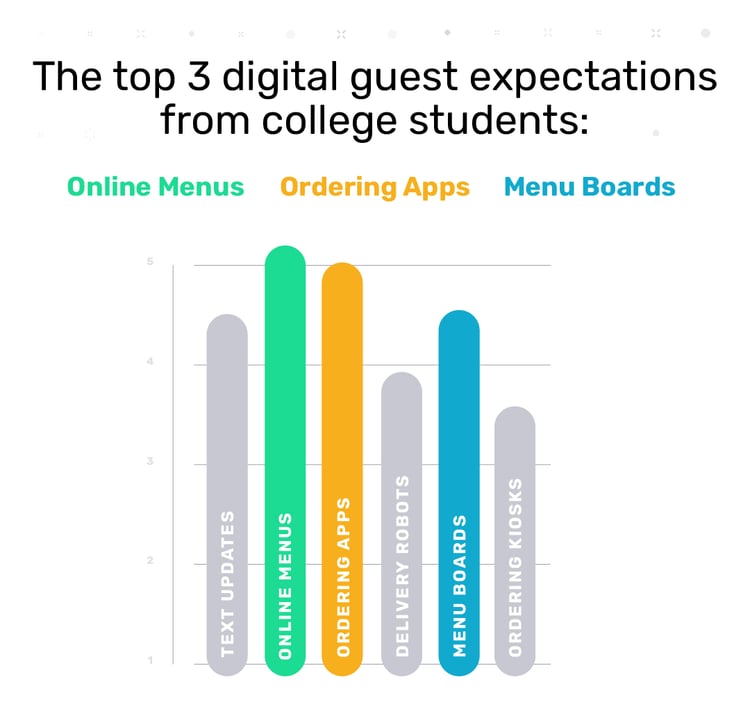It’s no secret: the scope of customer experience in higher education foodservice is wider than it used to be. Of course, brick-and-mortar experiences are as important as they’ve always been — students expect clean spaces, fast service, and friendly staff.
But today, students’ customer experience also extends to web, mobile, digital displays, and beyond.
What makes a digital experience a good one? We surveyed nearly 800 current college students, and here’s what they told us:
What does “digital experience” mean in higher ed. foodservice?
We get it – the full spectrum of digital innovation can be just a tad overwhelming.
So this is what we mean when we say “digital experience”:
- Web and online menus
- Ordering apps
- Digital menu boards
- Text updates and order notifications
- Delivery robots
- Ordering kiosks
But before you get your welding gear out, know this: it isn’t fancy, meal-toting cyborgs that pique most students’ interest. Most place far more weight on connected, cloud-based experiences that make interactions seamless.
Students prioritize cloud-based experiences.
We asked survey respondents to rank digital experiences offered by on-campus foodservice providers in order of importance.
Students’ top three priorities were:
- Web and online menus
- Ordering apps
- Digital menu boards
Nearly a third (32%) of students told us that online menus were the number-one most important digital offering, while another 18% ranked them second. (They also told us not all menus are created equal.)
Meanwhile, a combined 44% of students put ordering apps in their top two, and 34% ranked digital menus first or second.

What makes a digital experience great?
Online menus, ordering apps, and digital signage reign supreme, so how can you ensure yours put their best feet forward? Let’s take a closer look at each of the three:
Online menus
Why students love them: College kids may seem impulsive, but more than 75% said they already have ideas of what they’ll order when they come to eat.
Students are used to having information at their fingerprints, and easy access to online menus can help them select between on-campus locations — or help them choose you over an off-campus competitor in the first place.
What makes them work: A great online menu is, above all, a thorough one. Students consistently tell us that what they want most when they browse your menus is information. The most important data point, unsurprisingly, is price, but students also crave descriptions and images as well as nutritional, ingredient, and allergen details.
With all that info to communicate, accessibility and design are the names of the game. Well-designed menus help showcase your offerings without overwhelming students.
Ordering apps
Why students love them: For a population on the go, there are few things more convenient than being able to order food directly from a phone. Ordering apps make it easy for students to buy from you even when there isn’t time for a sit-down meal.
What makes them work: The ordering process must be a seamless one, no matter how much complexity is lurking behind the scenes. Up-to-date information, order customization, and live status updates (in-app or via text or email) make the experience something students can count on.
Digital signage/menu boards
Why students love them: Menu boards are where digital meets physical. Digital displays offer students attractive, informative screens that help them finalize their mealtime decisions.
What makes them work: Great digital signage grabs students’ attention with amazing imagery and engages them with intuitive design. Your menu boards should connect to a central system so they’re always up-to-date, and should offer all the details students want about their meals in a way that gets them excited and showcases your priority offerings.
Why digital experiences matter in foodservice...
Just because your digital experience isn’t something you can taste or see doesn’t mean it has no real impact on your customers. We asked students what they’d think if they encountered inaccurate information on a digital menu board, and the results weren’t pretty:
- 57% said they’d have reduced confidence in the campus dining team
- 55% would question information moving forward
- 42% said their trust in the quality of food would decrease
Digital experiences play a major role in the way students assess your performance. Falling short can negate all of the hard work you’ve poured into your operation, while meeting or exceeding digital expectations can help your customer experience shine.
Next up in the final post of our survey series, we’ll jump into the importance of menu transparency. Be sure to check it out!
You can also read the previous posts in this series if you missed them:
Part one: Here's the Digital Menu Information College Students Want to See
Part two: Over 70% of College Students Say Menu Boards Matter — Here's Why
